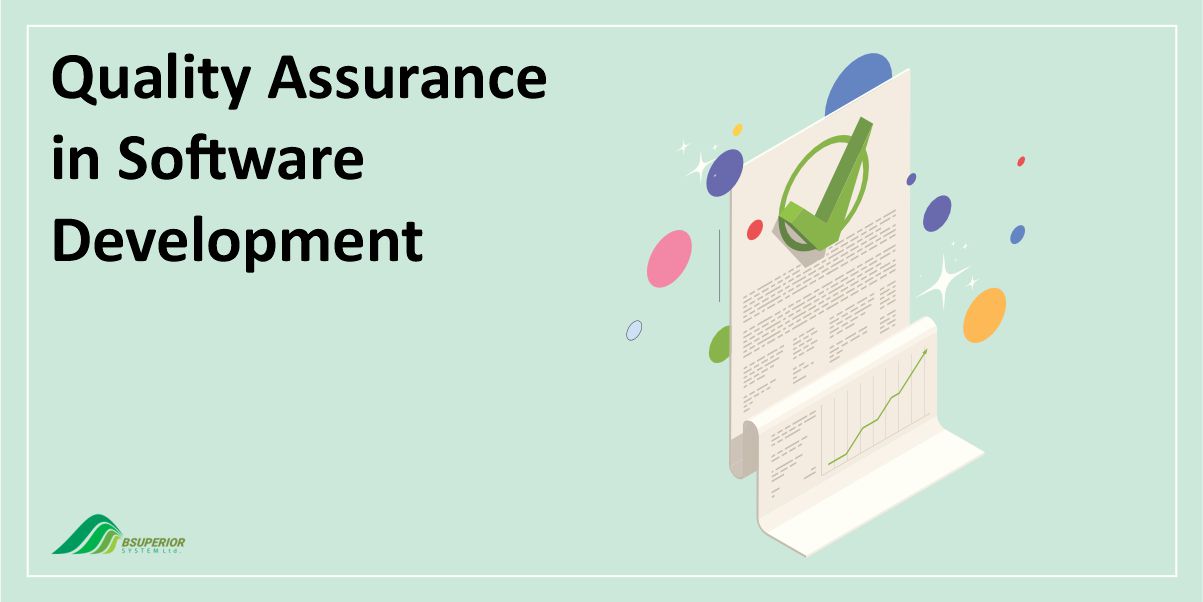Quality Assurance in Software Development: The Things You’d Better Know

Quality assurance is an inseparable element in software development that must not be downplayed. Through investment in quality assurance procedures, development teams will be able to verify that their final products are on par with the desired standards.
Given the significance of quality assurance, we’re going to discuss this important aspect of software development in this blog post and explain why companies should prioritize it.
What is Quality Assurance in Software Development?
Broadly speaking, quality assurance (QA) involves a comprehensive approach to verify that a product is reliable, performs as expected, and fulfills customer satisfaction.
It involves continuous testing and refinement throughout the product’s development or update cycle to detect and fix any defects prior to its release to end-users.
Within the context of software development, QA refers to the systematic procedures implemented to make sure that the software meets the criteria for functionality, dependability, and security.
This includes a variety of tasks such as planning tests, coming up with test scenarios, conducting testing, documenting bugs, and monitoring fixes.
Rather than being an isolated step, software quality assurance (SQA) runs alongside the entire process of building software, checking that everything from the inside out meets a specific quality level.
Businesses need to guarantee every piece of the software is good, both the parts users see and the hidden inner workings. To achieve this, QA checks each step along the way to catch problems before they become big issues.
Read More: Top 7 Software Solutions For Inventory Management in 2024
How is Quality Assurance Different From Quality Control?
Software development relies on two key processes to determine quality: Software Quality Assurance (SQA) and Software Quality Control (SQC). Although they sound similar, they are different in a few important ways.
SQA is all about managing the way things are done to avoid mistakes and problems for the person who ends up using the product.
It is a proactive approach that focuses on preventing defects from happening in the first place. QA looks at the entire development process, from design to coding, to identify potential issues and establish quality standards. It’s like a validation process to ensure that the software is built the right way from the start.
SQC, on the other hand, is looking at the finished product to make sure that it won’t come with any issues such as defects or damage before it gets to the customer.
In other words, QC comes into play after the software is built. It uses testing, code reviews, and inspections to find and fix bugs and errors.
While QA is a validation process, QC is a verification process that makes sure the final product meets the specified quality criteria.
We can summarize the differences between the two software quality approaches as follows:
GOAL
- QA: Proactive that aims to prevent defects and ensure high-quality software throughout development.
- QC: Reactive that focuses on finding and fixing defects after they occur, ensuring the software meets pre-defined standards.
APPROACH
- QA: Preventive – confirms that the software meets user needs
- QC: Corrective – verifies that the software meets specifications
ROLE
- QA: Process-focused which involves activities such as designing, auditing, and training for quality processes.
- QC: Testing-focused which involves testing, code reviews, and inspections of the software itself.
WHO DOES IT
- QA: Wider team involvement – project managers, testers, developers, and other stakeholders.
- QC: Primarily testers, developers, and sometimes external reviewers.
TIMING
- QA: Throughout the whole software development lifecycle.
- QC: Typically during the testing and validation phases, and after the development is complete.
Read More: What is MVP in Software Development? Types and Differences
What are the Main Principles of QA in Software Development?
Having discussed QA, now let’s move on to the nitty-gritty which are the major principles that make it work effectively. By following these principles, your QA process will run as smoothly as possible.
- Stopping the Bugs Before They Appear: The best way to deal with software problems is to prevent them altogether. That is the idea behind defect prevention. By finding and fixing potential issues early in development, you will be avoiding costly fixes later on.
- Always Getting Better: QA is an ongoing process that works hand-in-hand with software development. This principle means constantly checking and improving the software’s quality throughout the whole build process.
- Teamwork: Effective QA requires everyone involved in the project to be on the same page. This includes customers, developers, testers, team leads, and project managers. By working together and communicating openly, everyone can contribute to a smooth development process that delivers high-quality software.
- Focusing on What Matters Most: Based on this principle, it is essential to emphasize identifying and tackling the most critical issues that could seriously impact the software. By prioritizing risks, QA teams will be able to make the most of their time and resources.
What are the Benefits of QA in Software Development?
As software development projects have become more complex over the years, the importance of QA has grown as well. Below we’ll be taking a look at 4 main reasons as to why QA procedures are beneficial to the software development process.
Guaranteeing Product Stability
One of the major purposes of QA in software development is to guarantee the stability of the product. Stability in this regard means that the software functions smoothly and error-free.
Thanks to rigorous testing and quality evaluations, QA experts can spot and resolve any defects, mistakes, or code discrepancies. This verification process ensures that the software adheres to the expected reliability standards, which is essential for user satisfaction as well as trust in the product.
Better User Experience
In addition to product stability, QA is pivotal in software projects to enhance the user experience (UX). UX is a vital element of any software that greatly influences user engagement and loyalty.
QA teams perform usability testing and other evaluations to pinpoint and resolve any UX issues before the software’s release. This mainly involves addressing slow response times, perplexing interfaces, or other UX challenges that might impact user satisfaction.
Maintenance and Sustainability
By prioritizing clear documentation of test results and reports, QA practices contribute to both easy maintenance and software sustainability.
This well-documented foundation makes it simpler to understand the original code and allows for smoother updates and easier troubleshooting in the future. In short, good QA practices will result in software that is built to last and adapt.
Saving Time and Resources
QA is a process that helps companies save time and money down the line. Identifying and correcting errors early in the development phase allows teams to prevent expensive revisions and delays that might arise if issues are discovered later.
Moreover, QA also helps pinpoint areas for improvement within the development process itself that will further cut costs and optimize development activities.
Complying with Standards and Regulations
Various industries and sectors mandate that software products comply with certain standards and regulations. This includes specific rules such as HIPAA for healthcare software or PCI for financial applications.
Through strict QA processes, development teams can ensure their software complies with these requirements, and thus avoid potential fines, penalties, or legal issues due to non-compliance.
Read More: 10 Best Ecommerce ERP Software in 2024
How Does Quality Assurance Work?
Just like any product, software needs to go through a series of quality checks before it reaches users. This quality check, as we mentioned above, is called Software Quality Assurance (SQA). Let’s see what steps are involved in the QA of software development.
1. Strategic Planning
Effective SQA starts with strategic planning. To avoid last-minute surprises, consider the following key elements:
- Understanding User Needs: Identifying your target audience’s expectations is considerably important. The better you understand their needs, the better you can tailor the software to their requirements. These needs will eventually define your quality standards.
- Defining Quality Standards: Once you know user needs, you can establish specific quality standards. While industry standards like ISO 9001 might apply, your team can also set software-specific standards based on the type of software being built.
- Developing the SQA Plan: This plan outlines the entire QA process in detail. It specifies the procedures, tools, and techniques your team will use to make sure that the final product meets your specified standards.
2. Implementing Quality Control
Now that you have your QA plan in place, it’s time to turn it into reality. At this stage, you should focus on three major areas:
- Multi-Angle Testing: Since a single test won’t be enough, it is important that you take a multi-testing approach.
A multi-testing strategy combines different approaches including unit testing, regression testing, and performance testing, to thoroughly examine the software from various angles and identify any potential defects. - Following the Plan: The QA team needs to verify that everyone on the development team is sticking to the established processes and standards.
Moreover, they must regularly check that established standards are being followed correctly and assess whether any adjustments need to be made to the processes. - Managing Change: Any modifications to code, features, and design are closely monitored using manual and automated tools to understand their impact on the software’s overall behavior.
In some cases, updates may be rolled out in stages to minimize disruption. The ultimate goal is to maintain software quality even when changes are introduced.
3. Evaluating Software Quality
After implementing the QA plan, it’s time to assess the software and ensure it meets the established quality standards. This thorough evaluation helps you prevent future problems and makes software maintenance easier.
- Rigorous Testing: Software is rigorously tested throughout the development by using a combination of manual and automated methods. Multiple tests are repeated as well to identify errors and avoid issues after deployment.
Testing mainly starts with unit testing and progresses to regression testing. What’s more, stress tests are performed to ensure the software can handle heavy use. - Process Audits: Audits compare the actual development process with the established guidelines. Any deviations or compliance issues at this step are identified and addressed quickly. The audit team then documents these issues and suggests changes to improve software quality.
- Measuring Change Impact: If changes are made based on the audit findings, your QA team will then measure the impact of those changes on the software.
Software quality metrics allow developers to track how the software performs after the proposed changes are implemented.
Once you’re confident with the software’s quality, you need to identify, fix, and document the errors that you have encountered. This will enable you to stop the errors from happening again, or if they occur, it will help you plan for a quicker fix to minimize any damage.
4. Final Touches and Continuous Improvement
The final stage of SQA focuses on continuous improvement and preparing the software for release. The QA team plays a central role in this step through monitoring improvements and documenting the SQA process for future use.
At this stage, the QA team identifies errors, sets goals for improvement, allocates resources, and defines how success will be measured.
They also make any necessary adjustments and continue the improvement cycle until the software is error-free and meets the quality standards defined earlier in the process.
Another important point to mention is that it is essential to maintain good relationships with developers throughout the QA process. It is by working together towards a common goal that conflicts can be minimized and a more collaborative environment will be fostered.
Final Words
Building a great software product takes time and resources, especially when it comes to QA. If your company doesn’t have a strong internal QA team, then outsourcing will be your best option.

At BSUPERIOR, we’re experts in all things QA. We can build a robust QA process from scratch, tailored to your specific needs. Whether you need basic manual testing or cutting-edge automation solutions, we’ve got you covered.
So, partner with BSUPERIOR today and get on the fast track to building a successful software product.
We value your input and believe this content may enhance our services. However, it's under review. If you see room for improvement, please use the "Report an issue" button below. Your feedback helps us excel.
Contact us today at –– and speak with our specialist.




